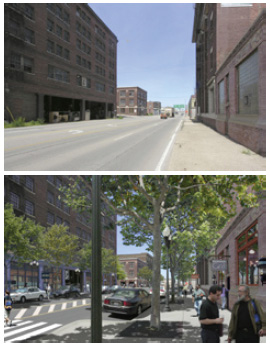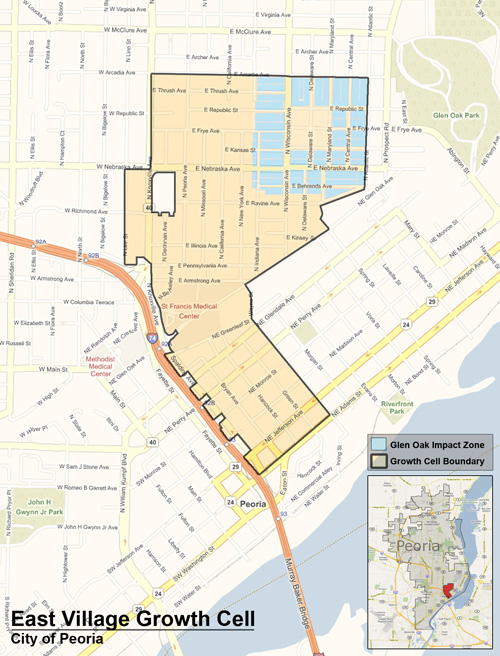The Journal Star reports (no link — it’s a “First in Print” article) that a new passenger rail advisory group has been formed:
A 21-member committee formed of local government officials and appointees from the Tri-County Regional Planning Commission, it set priorities in its first couple of meetings. In the long run, the goal would be passenger service that links downstate’s three Amtrak lines with service from Galesburg to Champaign. That starts with service from East Peoria to Normal.
The article is by columnist Terry Bibo, and unfortunately she doesn’t list any members of the committee other than Tazewell County board member Dean Grimm (who’s the chairman) and Tri-County Regional Planning director Terry Kohlbuss. It might be helpful to know who is making these decisions.
You might think from reading the quote above that the committee only wants to see rail service between East Peoria and Normal, but not so fast:
[T]ransportation officials are applying for a $160,000 grant for alternatives analysis. The grant would look at possibilities from carpooling to buses to rail service.
Kohlbuss is quoted later as saying he sees it as “a ramp-up process” to increase the number of rail users and build up demand. Grimm recognized the need for public support, saying, “I would hope people in Peoria — in central Illinois — value passenger train transportation. That’s the only way this is going to fly.” State Sen. Dave Koehler and Peoria Mayor Jim Ardis are reportedly already on board with the committee’s goals. I heard that Transportation Secretary Ray LaHood was on the radio this morning singing the praises of this plan as well. (LaHood, you may recall, used to be against rail service, saying people should just drive to Bloomington.)
My take: This is terribly disappointing in so many ways, I hardly know where to start.
On the positive side, I want to say that I’m glad our local leaders are focusing more attention on passenger rail. We need our local leaders’ buy-in so that the money can be appropriated and the project can happen. That there’s a committee formed is a good start in principle, although I would like to know who exactly is on it.
I knew a committee was being formed and expressed interest in being on it myself, but obviously the decision was made not to include me. That’s a little disappointing, given that I’ve started a grassroots organization called the Peoria Passenger Rail Coalition and have talked to the Mayor and Kohlbuss about my interest in working with them. But hey, they have their reasons (probably very good ones) and it’s their right to choose who they want and don’t want on their committee. I have no complaint about that.
I do have a complaint about their plans, however.
First of all, the timing is unfortunate. There is still an Amtrak-IDOT study pending that’s looking at the feasibility of establishing Peoria-Chicago passenger rail service. We really should see the results of that study before we assume it can’t be done and start looking at least-desired options. I fear this new development could influence the current study — perhaps even lead to its abandonment — if IDOT and Amtrak feel the political will is gone for a Peoria-Chicago connection.
Secondly, the plan itself is flawed. There is no demand of which I’m aware for rail access to Bloomington. If you’re going to Bloomington, you’re going to need a car in order to get around their sprawling city (likewise for anyone from Bloomington who would be traveling to Peoria). If you’re coming from Chicago, it’s reasonable to take the train and rent a car or take the bus in Bloomington. But it would be absurd to take the train from Peoria to Bloomington and then rent a car or take the bus. We’re so close to Bloomington that people traveling there are going to drive, period. It’s simply not a viable rail destination from Peoria.
Equally implausible is that sufficient numbers of people will want to take a train to Bloomington simply to connect with a Chicago- or St. Louis-bound train. To be sure, there would be some ridership for such a service, but not enough to sustain it. It would add time and cost that could be saved by driving to Bloomington and parking for free at their Amtrak station. How many Peoria residents already drive to Bloomington to take advantage of cheaper airfares and free parking at the Central Illinois Regional Airport? The same thing would likely occur here.
At least there’s a reason to go to Bloomington — to catch another train. Looking at it the other way, why would anyone want to travel from Bloomington to Peoria? Or East Peoria, for that matter. I mean, is there any chain restaurant or big box store in East Peoria that Bloomington doesn’t already have? What’s the attraction, exactly?
The most dangerous thing about this plan, however, is Grimm’s final quote — remember he said, “I would hope people in Peoria — in central Illinois — value passenger train transportation.” What this means is, if the Peoria-Bloomington rail link is a failure (as I believe it would be), then our local officials are going to believe that means people in Peoria and central Illinois don’t value train transportation. And that would be a travesty.
Central Illinois does value train travel, and will use train transportation — but only if it’s a viable route that goes where we want to go. We don’t want to go to Bloomington. We want to go to Chicago. Establish Peoria to Chicago passenger rail service and you will see success.

 U.S. Route 24 and Illinois Route 29 run through the Warehouse District in downtown Peoria, and that’s causing a problem for the City. The City wants to make Washington Street more pedestrian friendly by narrowing it and adding on-street parking on both sides of the road. Property owners in that area say they need a more pedestrian-friendly Washington Street in order to successfully redevelop those old warehouses into loft apartments, condos, retail shops, and restaurants. Because of the road’s designation as Routes 24 and 29, any changes to the street must be approved by the Illinois Department of Transportation, and they don’t want parking on both sides of the street. In fact, they prefer it wide and fast, just like it is now.
U.S. Route 24 and Illinois Route 29 run through the Warehouse District in downtown Peoria, and that’s causing a problem for the City. The City wants to make Washington Street more pedestrian friendly by narrowing it and adding on-street parking on both sides of the road. Property owners in that area say they need a more pedestrian-friendly Washington Street in order to successfully redevelop those old warehouses into loft apartments, condos, retail shops, and restaurants. Because of the road’s designation as Routes 24 and 29, any changes to the street must be approved by the Illinois Department of Transportation, and they don’t want parking on both sides of the street. In fact, they prefer it wide and fast, just like it is now.